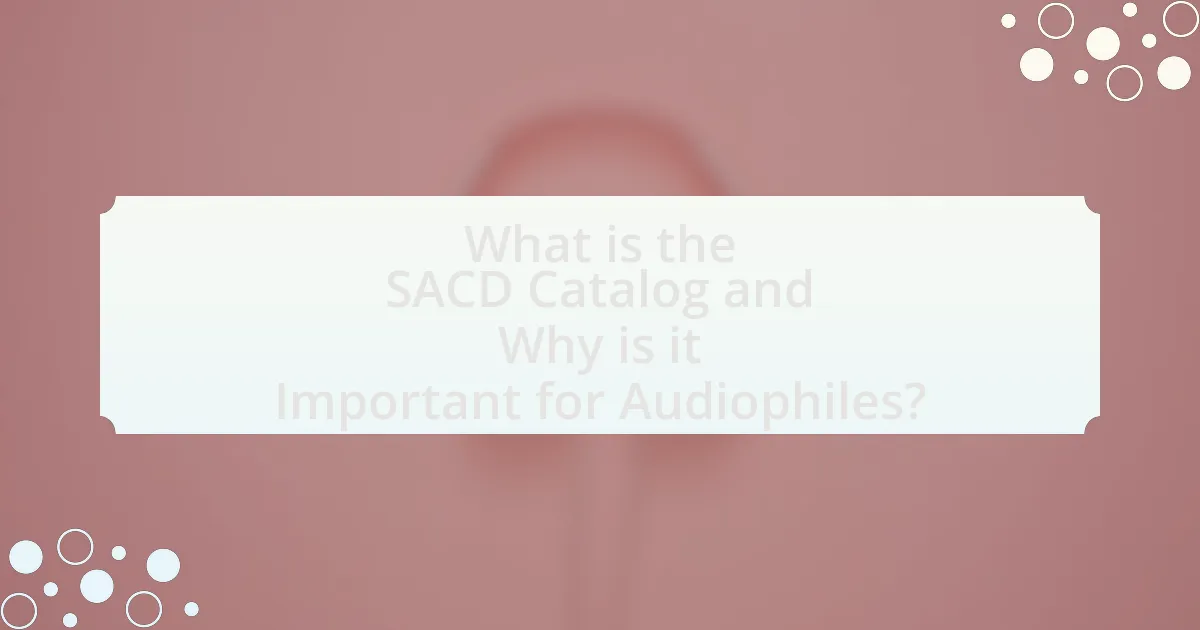The SACD Catalog is a curated collection of Super Audio CD titles that provide high-resolution audio quality, essential for audiophiles seeking superior sound fidelity. This article explores the unique features of the SACD format, including its use of Direct Stream Digital (DSD) encoding, multi-channel audio capabilities, and the technical specifications that distinguish it from standard audio formats. Key genres represented in the catalog, must-have albums for audiophiles, and strategies for effectively exploring and building a SACD collection are also discussed. Additionally, the article addresses the challenges of collecting SACDs and offers tips for maintaining their quality, ensuring a comprehensive understanding of the SACD experience for enthusiasts.
What is the SACD Catalog and Why is it Important for Audiophiles?

The SACD Catalog is a collection of Super Audio CD titles that offer high-resolution audio quality, which is crucial for audiophiles seeking superior sound fidelity. This catalog is important because it provides access to recordings that utilize advanced audio technology, allowing listeners to experience music with greater detail and clarity compared to standard CDs. The SACD format supports multi-channel audio and higher sampling rates, making it a preferred choice for those who prioritize audio quality in their listening experience.
How does the SACD format differ from other audio formats?
The SACD format differs from other audio formats primarily through its use of Direct Stream Digital (DSD) encoding, which allows for higher resolution audio than standard formats like CD or MP3. SACD supports multi-channel audio, enabling a surround sound experience, while traditional formats typically offer stereo sound. Additionally, SACD discs can contain both high-resolution audio and standard CD audio, providing versatility for playback on different systems. This high-resolution capability is supported by the fact that SACD can deliver audio at a sampling rate of 2.8224 MHz, significantly surpassing the 44.1 kHz of CDs, resulting in a more detailed and dynamic sound reproduction.
What technical specifications make SACD unique?
SACD, or Super Audio CD, is unique due to its use of Direct Stream Digital (DSD) encoding, which captures audio at a higher sampling rate of 2.8224 MHz, significantly surpassing the standard CD’s 44.1 kHz. This high-resolution audio format allows for a greater dynamic range and improved sound quality, making it particularly appealing to audiophiles. Additionally, SACDs can store both stereo and multi-channel audio, providing a more immersive listening experience. The physical disc structure also allows for hybrid formats, enabling compatibility with standard CD players while offering enhanced audio quality on SACD-compatible devices.
Why do audiophiles prefer SACD over other formats?
Audiophiles prefer SACD over other formats primarily due to its superior audio quality, which is achieved through higher resolution and better dynamic range. SACD utilizes Direct Stream Digital (DSD) encoding, allowing for a sampling rate of 2.8224 MHz, significantly higher than the 44.1 kHz of standard CDs. This higher resolution results in more accurate sound reproduction, capturing nuances in music that other formats may miss. Additionally, SACDs often include multi-channel audio options, providing an immersive listening experience that stereo formats cannot match.
What are the key features of the SACD Catalog?
The key features of the SACD Catalog include high-resolution audio quality, multi-channel sound options, and a diverse selection of genres. SACDs (Super Audio CDs) offer audio fidelity that surpasses standard CDs, providing a richer listening experience. The multi-channel sound capability allows for immersive audio setups, enhancing the overall enjoyment of music. Additionally, the SACD Catalog encompasses a wide range of music styles, from classical to contemporary, catering to various audiophile preferences.
How is the SACD Catalog organized?
The SACD Catalog is organized primarily by genre, artist, and release date. This systematic arrangement allows users to easily navigate through various categories, facilitating the discovery of must-have albums for audiophiles. For instance, genres such as classical, jazz, rock, and pop are distinctly categorized, while artists are listed alphabetically within each genre, and release dates provide chronological context for the albums. This structured approach enhances user experience and accessibility within the catalog.
What genres are most represented in the SACD Catalog?
The genres most represented in the SACD Catalog are classical, jazz, and rock. Classical music dominates the catalog due to its rich history and demand for high-fidelity sound, with numerous orchestral and chamber works available. Jazz follows closely, as audiophiles appreciate the genre’s intricate soundscapes and improvisational elements, leading to a significant number of SACD releases. Rock music also holds a prominent place, particularly classic rock albums that benefit from the enhanced audio quality of SACD format. These genres collectively reflect the preferences of audiophiles seeking superior sound experiences.
What are the must-have albums in the SACD Catalog for audiophiles?
The must-have albums in the SACD catalog for audiophiles include “Kind of Blue” by Miles Davis, “Dark Side of the Moon” by Pink Floyd, and “Aja” by Steely Dan. These albums are renowned for their exceptional sound quality and are frequently cited in audiophile circles. “Kind of Blue,” released in 1959, is celebrated for its innovative modal jazz and has been remastered in SACD format to enhance its sonic depth. “Dark Side of the Moon,” originally released in 1973, is praised for its intricate production and has been a benchmark for audio fidelity, particularly in its SACD release. “Aja,” released in 1977, showcases Steely Dan’s meticulous studio craftsmanship and is noted for its clarity and dynamic range in the SACD format. These albums are essential for any audiophile’s collection due to their historical significance and superior audio presentation.
Which classic albums are essential for any SACD collection?
Essential classic albums for any SACD collection include “Kind of Blue” by Miles Davis, “Dark Side of the Moon” by Pink Floyd, and “Aja” by Steely Dan. “Kind of Blue,” released in 1959, is widely regarded as one of the greatest jazz albums of all time, showcasing innovative modal jazz techniques. “Dark Side of the Moon,” released in 1973, is celebrated for its groundbreaking production and conceptual depth, making it a staple in rock music. “Aja,” released in 1977, is noted for its sophisticated arrangements and fusion of jazz and rock elements. These albums are frequently highlighted in audiophile circles for their exceptional sound quality and musical significance.
What contemporary releases should audiophiles consider?
Audiophiles should consider contemporary releases such as “A Moon Shaped Pool” by Radiohead, “To Pimp a Butterfly” by Kendrick Lamar, and “Blackstar” by David Bowie. These albums are available in high-resolution formats, including SACD, which enhances audio fidelity. “A Moon Shaped Pool” features intricate soundscapes and dynamic range, while “To Pimp a Butterfly” incorporates diverse musical styles and complex production techniques. “Blackstar” is noted for its innovative arrangements and deep emotional resonance, making it a standout in high-quality audio formats.
How can audiophiles effectively explore the SACD Catalog?
Audiophiles can effectively explore the SACD catalog by utilizing dedicated online databases and resources that list available titles, such as the SA-CD.net website, which features user reviews and detailed information about each release. Additionally, audiophiles should participate in forums and communities focused on high-resolution audio, where they can share recommendations and discover lesser-known SACDs. Engaging with retailers that specialize in high-fidelity audio equipment can also provide insights into popular and critically acclaimed SACD releases, enhancing their exploration experience.
What resources are available for discovering new SACD titles?
Online databases and music retailers are key resources for discovering new SACD titles. Websites like Discogs and MusicBrainz provide extensive catalogs of SACD releases, including user-generated content and reviews. Additionally, specialized audiophile retailers such as Acoustic Sounds and Elusive Disc frequently update their inventories with new SACD titles and offer recommendations. These platforms not only list new releases but also feature user reviews and ratings, helping audiophiles make informed choices.
How can audiophiles evaluate the quality of SACD releases?
Audiophiles can evaluate the quality of SACD releases by analyzing the mastering quality, dynamic range, and the source material used in the production. High-quality SACDs typically feature remastered audio from original analog tapes, which enhances sound fidelity. Additionally, audiophiles often refer to reviews from reputable audio publications and forums that discuss the specific SACD release, providing insights into its sound quality and overall performance. The dynamic range, measured in decibels, is crucial as it indicates the difference between the quietest and loudest parts of the recording; a greater dynamic range usually signifies better audio quality. Furthermore, listening tests on high-fidelity audio systems can help audiophiles discern subtle differences in sound reproduction, confirming the quality of the SACD.
What are the benefits of owning SACD albums?

Owning SACD albums provides superior audio quality compared to standard CDs, as SACDs utilize a higher sampling rate and bit depth, resulting in more detailed sound reproduction. This enhanced audio fidelity is particularly beneficial for audiophiles who seek an immersive listening experience. Additionally, SACDs often include multi-channel audio options, allowing for surround sound playback, which further enriches the listening experience. The format also supports hybrid discs, enabling compatibility with both SACD and standard CD players, thus offering versatility for users.
How does SACD enhance the listening experience?
SACD enhances the listening experience by providing superior audio quality through its high-resolution audio format. This format supports multi-channel sound, allowing for a more immersive listening experience compared to standard CDs. SACDs can deliver audio at a sampling rate of up to 2.8224 MHz, which is significantly higher than the 44.1 kHz of CDs, resulting in greater detail and clarity in sound reproduction. Additionally, the DSD (Direct Stream Digital) encoding used in SACDs captures audio in a way that closely resembles analog sound, further enriching the listening experience for audiophiles.
What role does high-resolution audio play in SACD enjoyment?
High-resolution audio significantly enhances SACD enjoyment by providing superior sound quality and detail. SACDs utilize a higher sampling rate and bit depth compared to standard CDs, allowing for a more accurate representation of the original recording. This results in clearer highs, deeper lows, and a more immersive listening experience, which is particularly appreciated by audiophiles. Studies have shown that listeners can perceive differences in audio quality, with high-resolution formats like SACD offering a dynamic range that exceeds that of traditional CDs, thus elevating the overall enjoyment of music.
How does the surround sound feature of SACD impact music enjoyment?
The surround sound feature of SACD significantly enhances music enjoyment by providing a more immersive listening experience. This multi-channel audio format allows sounds to be distributed across various speakers, creating a three-dimensional soundstage that traditional stereo cannot replicate. Research indicates that listeners often perceive greater depth and clarity in music when experienced in surround sound, as it allows for more nuanced audio details and spatial effects. This immersive quality can lead to increased emotional engagement with the music, making it more enjoyable for audiophiles who appreciate the intricacies of sound.
What are the challenges of collecting SACD albums?
Collecting SACD albums presents several challenges, primarily due to their limited availability and high cost. The production of SACDs has decreased significantly since their peak, making it difficult for collectors to find specific titles. Additionally, many SACDs are released in limited editions, which can drive up prices in the resale market. The compatibility of SACD players also poses a challenge, as not all standard CD players can play SACDs, limiting access for some collectors. Furthermore, the niche market for SACDs means that many mainstream retailers do not stock them, requiring collectors to seek out specialized shops or online marketplaces, which can complicate the purchasing process.
How can audiophiles overcome the limited availability of SACD titles?
Audiophiles can overcome the limited availability of SACD titles by exploring alternative formats and utilizing online marketplaces. Many audiophiles turn to high-resolution digital downloads or streaming services that offer similar audio quality, as these platforms often have a broader selection of music. Additionally, online marketplaces like eBay or Discogs provide access to rare and out-of-print SACD titles, allowing audiophiles to expand their collections. This approach is supported by the growing trend of digital music consumption, which has seen a significant increase in high-resolution audio offerings, making it easier for enthusiasts to find and enjoy quality music.
What are the common misconceptions about SACD quality?
Common misconceptions about SACD quality include the belief that SACD inherently sounds better than standard CDs and that all SACDs are high-resolution. While SACDs can offer superior sound quality due to their higher sampling rates and bit depth, the actual audio experience depends on the specific recording and mastering quality. Additionally, not all SACDs utilize the full capabilities of the format; some may only provide a standard CD layer, which does not enhance audio quality.
What tips can audiophiles use to build a great SACD collection?

Audiophiles can build a great SACD collection by focusing on high-quality recordings, diverse genres, and limited editions. Prioritizing SACDs that feature well-mastered audio from reputable labels, such as Sony and Universal Music, ensures superior sound quality. Exploring various genres, including classical, jazz, and rock, allows for a well-rounded collection that showcases the format’s capabilities. Additionally, seeking out limited edition releases can provide unique listening experiences and potential future value, as these often feature exclusive content or enhanced audio quality. Collectively, these strategies enhance the overall listening experience and investment in a SACD collection.
How should audiophiles prioritize their SACD purchases?
Audiophiles should prioritize their SACD purchases by focusing on titles that offer superior sound quality and unique recordings. This includes selecting albums known for their exceptional mastering and those that utilize the multi-channel capabilities of SACD to enhance the listening experience. For instance, classic jazz and orchestral recordings often benefit from the high-resolution audio format, making them ideal choices. Additionally, audiophiles should consider limited edition releases or titles that are exclusive to SACD, as these can provide unique listening experiences not available in other formats. Prioritizing these factors ensures that audiophiles maximize the value and enjoyment of their SACD collections.
What factors should be considered when selecting SACD albums?
When selecting SACD albums, consider the audio quality, genre preference, and artist reputation. Audio quality is paramount, as SACDs are designed to deliver superior sound through high-resolution formats. Genres should align with personal taste, as SACDs span various styles, from classical to rock. Artist reputation can indicate the likelihood of a well-produced album, as established artists often collaborate with skilled producers and sound engineers. Additionally, reviews and recommendations from audiophile communities can provide insights into the best SACD releases, ensuring a satisfying listening experience.
How can audiophiles stay updated on new SACD releases?
Audiophiles can stay updated on new SACD releases by subscribing to specialized music newsletters, following dedicated websites, and joining online forums focused on high-fidelity audio. Websites like SA-CD.net provide comprehensive lists of new releases and reviews, while newsletters from record labels often announce upcoming SACDs. Additionally, audiophile forums and social media groups facilitate discussions and share information about the latest SACD offerings, ensuring enthusiasts remain informed about new titles and reissues.
What are the best practices for maintaining SACD quality?
To maintain SACD quality, it is essential to store discs in a cool, dry environment away from direct sunlight and humidity. Proper handling is crucial; always hold the edges of the disc to avoid fingerprints and scratches. Additionally, using a high-quality SACD player that supports the format’s specifications ensures optimal playback. Regularly cleaning the player’s laser lens can prevent playback issues and maintain sound fidelity. These practices are supported by industry standards that emphasize the importance of environmental conditions and equipment quality in preserving audio formats.
How should SACD discs be stored and handled?
SACD discs should be stored vertically in a cool, dry environment to prevent warping and damage. Storing them upright minimizes pressure on the disc surface, while maintaining a temperature between 60°F and 75°F (15°C to 24°C) helps preserve the integrity of the disc material. Additionally, handling SACD discs by the edges and avoiding contact with the surface reduces the risk of fingerprints and scratches, which can affect playback quality. Proper storage and handling practices are essential for maintaining the longevity and performance of SACD discs.
What cleaning methods are recommended for SACD discs?
Recommended cleaning methods for SACD discs include using a microfiber cloth to gently wipe the surface in a straight line from the center to the edge, avoiding circular motions that can cause scratches. Additionally, a specialized disc cleaning solution can be applied to the cloth to enhance cleaning without damaging the disc. It is important to avoid using abrasive materials or harsh chemicals, as these can harm the disc’s protective layer and affect playback quality.

Leave a Reply